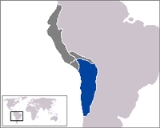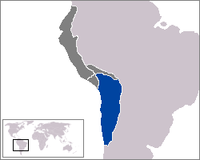
Pukara de La Compañia
Encyclopedia
Pucara
de La Compañia, is a promaucae fortress, later used by Incas, with remains located in La Compañia Mount, commune of Graneros
, Chile
. It is notable as the southern-most building which remains of the Inca Empire
. It was declared a National Monument
of Chile.
 There are three main historical periods during which the pucará was occupied:
There are three main historical periods during which the pucará was occupied:
of cellular telephony on one of the points of the summit of the Mount. The works of installation of this structure, realized in 1997, included an access way and movements of land, which destroyed 4 metres (13 ft) of a defensive wall.
Pucará
A pucará is a term that refers to the ruins of the fortifications made by the natives of the central Andean cultures and particularly to those of the Inca...
de La Compañia, is a promaucae fortress, later used by Incas, with remains located in La Compañia Mount, commune of Graneros
Graneros
Graneros is a Chilean commune and city in Cachapoal Province, O'Higgins Region.-Demographics:According to the 2002 census of the National Statistics Institute, Graneros spans an area of and has 25,961 inhabitants . Of these, 22,674 lived in urban areas and 3,287 in rural areas...
, Chile
Chile
Chile ,officially the Republic of Chile , is a country in South America occupying a long, narrow coastal strip between the Andes mountains to the east and the Pacific Ocean to the west. It borders Peru to the north, Bolivia to the northeast, Argentina to the east, and the Drake Passage in the far...
. It is notable as the southern-most building which remains of the Inca Empire
Inca Empire
The Inca Empire, or Inka Empire , was the largest empire in pre-Columbian America. The administrative, political and military center of the empire was located in Cusco in modern-day Peru. The Inca civilization arose from the highlands of Peru sometime in the early 13th century...
. It was declared a National Monument
National Monuments of Chile
The National Monuments of Chile , also abbreviated MN, are the constructions, elements and places that form part of the country's cultural heritage, and they are protected by law...
of Chile.
History

- Between years 1380 and 1450, of archaeological decades, the hill would have been in use, with purposes that they seem to relate to the resistance of the local population, promaucaesPromaucaesPromaucaes, Promaucas or Purumaucas ; pre-Columbian Mapuche tribal group that lived in the present territory of Chile, south of the Maipo River basin of Santiago, Chile and the Itata River,...
or picunchePicuncheThe Picunche , also referred to as picones by the Spanish, were a mapudungun speaking Chilean people living to the north of the Mapuches or Araucanians and south of the Choapa River and the Diaguitas...
s, to the Inca invasion. - Most of the Inca structures and remains of the hill fit to the occupation, between the years 1430 and 1450, approximately.
- Again the indigenous local population gave the last use to the fortress, trying to resist the conquestConquest of ChileThe Conquest of Chile is a period in Chilean historiography that starts with the arrival of Pedro de Valdivia to Chile in 1541 and ends with the death of Martín García Óñez de Loyola, in the Battle of Curalaba in 1598 or alternatively with the Destruction of the Seven Cities. This was the period...
by SpainSpainSpain , officially the Kingdom of Spain languages]] under the European Charter for Regional or Minority Languages. In each of these, Spain's official name is as follows:;;;;;;), is a country and member state of the European Union located in southwestern Europe on the Iberian Peninsula...
. The proofs of this event that appear in the former chronicleChronicleGenerally a chronicle is a historical account of facts and events ranged in chronological order, as in a time line. Typically, equal weight is given for historically important events and local events, the purpose being the recording of events that occurred, seen from the perspective of the...
s were those who guided archeologists to them, and they allowed to relocate the pucará in recent years.
Description
The vestiges of the pucará consist of the bases of 7 structures of circular plant, a major construction and other attached buildings that can be sites (places) of alertness. The flat summit of the hill is surrounded, in addition, with defensive perimeter walls.Current situation
Cerro La Compañia was declared a Chile National Monument by the Decree No. 1191, dated March 11, 1992. In spite of it, these remains have neither a tourist-suitable access, nor control and care on the part of the authorities. An attitude that denotes little respect for the archaeological patrimony of the pucará is the existence of a great antennaAntenna (radio)
An antenna is an electrical device which converts electric currents into radio waves, and vice versa. It is usually used with a radio transmitter or radio receiver...
of cellular telephony on one of the points of the summit of the Mount. The works of installation of this structure, realized in 1997, included an access way and movements of land, which destroyed 4 metres (13 ft) of a defensive wall.
See also
- Qullasuyu
- Cachapoal Valley
- Pucara de Quitor
- Huaca de ChenaHuaca de ChenaHuaca de Chena , also known as the Pucará de Chena, allegedly one promaucae fortress , rather an astronomic observatory and sacred Huaca, used by them Incas, located on Cucara Point , small orographical eminence that stands out towards the south of Chena Mountain, in the basin of San Bernardo ,...
- Pucara del Cerro La MurallaPucara del Cerro La MurallaPucará de Cerro La Muralla is a Pucara , probably Inca on a strategic mountain top, five km to the south of San Vicente de Tagua Tagua, to the south side of the dry lagoon . This is southernmost pucará of the Inca Empire.- History :The Inca invasion, having advanced beyond the Choapa river, came...
External links
- Cerro de La Compañía Google Maps
- Official website of Pucará de La Compañía del Consejo de Monumentos Nacionales de Chile.
- M. T. Planella, B. Tagle, R. Stehberg y H. Niemeyer; Achievements and failures in the stage of recovery of a historical damaged patrimony: the case of the strength(fortress) of the Big Hill of The Company ". Chungará, sep. 2004.
- http://www.municipalidadgraneros.cl/monumentos/ Pucará de La Compañía ,official site of the Municipality of GranerosGranerosGraneros is a Chilean commune and city in Cachapoal Province, O'Higgins Region.-Demographics:According to the 2002 census of the National Statistics Institute, Graneros spans an area of and has 25,961 inhabitants . Of these, 22,674 lived in urban areas and 3,287 in rural areas...
]

